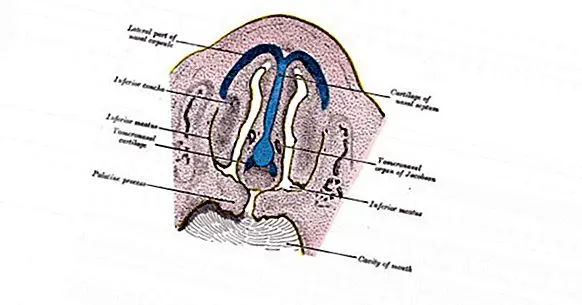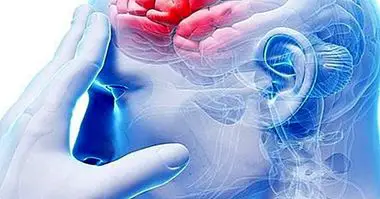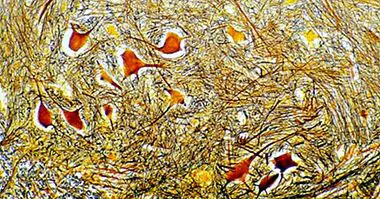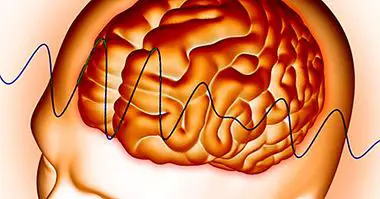Vomeronasal organ: what it is, location and functions
The world of smells is fascinating. Although we are probably in the least developed sense in the human being, thanks to this sense we are able to perceive very diverse aromas that have different effects on us, and even taste what we eat.
But not everything we can grasp when we inhale are smells. And is that the vast majority of mammals has an internal organ that is capable of detecting pheromones. We are talking about vomeronasal organ, common to a large number of mammals and whose existence and functionality in human beings has often been discussed.
- Related article: "Olfactory bulb: definition, parts and functions"
The vomeronasal organ: description and location
We call the vomeronasal organ a structure present in a large number of living beings and in humans (although depending on the study it is affirmed that it is part of all human beings or that only a percentage of them possess it), which it serves as an auxiliary organ of the olfactory system .
Is about a group of sensitive receptors specialized in pheromone uptake , chemical signals left by living beings and that serve as a message to other beings whether or not they are of the same species. These receptors are connected to bipolar neurons that have connections with the hypothalamus and the olfactory bulb.
The vomeronasal organ is also called the Jacobson organ in honor of Ludwig Lewin Jacobson , who gave it its original name (vomeronasal organ) after studying the structure that Frederik Ruysch had seen and described (being the first to do so) after observing a structure in the anterior part of the nasal septum of a corpse. Jacobson, also, visualized this organ in various animals and noticed a lack of development of this structure in the case of the human being.
In the human being this organ is a bilateral tube that can have several forms, the most common being that of a conical sac, which is located anterior to the vomer bone and below the respiratory mucosa. It is communicated with the nasal cavity and is covered with epithelial tissue .
In many animals there is an internal pump formed by blood vessels that, on contracting, allow the pheromones to be absorbed and captured. However, this does not occur in humans, being a membranous organ that does not have a great vascularization.
- Perhaps you are interested: "Parts of the Nervous System: functions and anatomical structures"
Jacobson's organ functions
The existence of the vomeronasal organ is a reality in a great majority of terrestrial animals. The main function associated with this organ is to capture the signals emitted by other members of the same species in order to transmit certain information . Pheromone uptake allows the animals to choose reproductive pairs with immune systems very different from their own (something that benefits potential offspring), to detect the health status of an animal of the same species, to warn potential sexual partners of being in the Mating or marking a social status.
As well It is very useful to many animals when it comes to detect and hunt their prey , as in the case of the ophidians (in fact, the typical movement of the tongue of the snakes contributes to make enter and approach the pheromones to this organ).
However, in other animals it does not seem to present a functionality, as in the case of aquatic mammals (dolphins and whales) and certain species of bats and apes.
Functions in the human being
With regard to human beings, as we mentioned above its functionality has been highly discussed . Traditionally it has been considered that the vomeronasal organ is a vestigial organ inherited from our ancestors and without a role in our organism, such as the coccyx, wisdom teeth or nipples in man.
However, the truth is that it has been observed that exposure to certain pheromones in the human vomeronasal organ can generate changes at the physiological level . In fact, it has been found that some aspects of our behavior or even our biology may depend on or vary through exposure to pheromones. The best known example is that of sexual attraction: there are people who, being unknown, attract us instinctively, regardless of their physical appearance or personality.
Also, there is another aspect that happens regularly and whose explanation is also hormonal: when several women coexist continuously for a while, their menstrual cycles tend to synchronize.Also, the presence of men who cohabit with the woman can also alter the menstrual cycle. Similarly, it has been observed Exposure to some hormones relaxes behavior and it decreases the level of aggressiveness in men, or it can increase your testosterone level.
Finally, it is also known the existence of certain pheromones emitted by mothers and babies who have a certain role in the union and mother-child bond and the behavior of any of them can be modified depending on the capture by the vomeronasal organ of some of them.
Commercial exploitation of pheromones
However, we must bear in mind that the existence of this organ and the role of pheromones in aspects such as sexual attraction has been used by a lot of brands to try to sell their products, selling different perfumes or even prepared with pheromones at commercial level.
In this sense we must take into account that first we ourselves already emit pheromones, being able to mix their own with those of other preparations to be confusing or even unpleasant, and we must bear in mind that sexual and romantic attraction is not limited only to the hormones that we give off.
In addition, it has to be considered that different pheromones can have different effects according to who gets them (for example, as we have said before at the level of sexual attraction, someone with an immune system very different from ours is more appetitive).
Bibliographic references:
- Naser, A .; Fullá, J.M .; Varas, M.A .; Nazar, S. (2008). The human vomeronasal organ. Journal of otorhinolaryngology and head and neck surgery, 68 (2). Santiago.
- Zeller, F.L. (2007). Normal anatomy and frequency of the Jacobson vomeronasal organ (OVN) in human fetuses. Rev. Argentina de Urología, 1 (72).



















